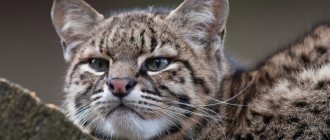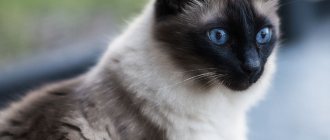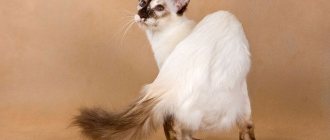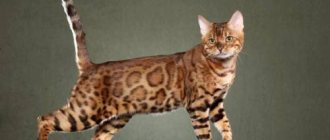The fishing cat or civet cat has recently attracted great interest among exotic lovers. There are also frequent attempts to keep it at home.
It should be remembered that this is not a breed of domestic cat, it is a natural variety of a wild predator. In order for coexistence to be comfortable for everyone, it is necessary to know everything about this rare species.
History of the discovery of the variety
Fishing cats have been known to the indigenous populations of many Asian countries since ancient times. These animals preferred to hide in the thickets of the tropical jungle during the day, so for a long time there were only legends about the ghost cat.
During the development of new territories, extensive deforestation and drainage of wetlands began. Viverrid cats had to adapt to new living conditions; they became more noticeable to people and, unfortunately, became objects of hunting.
Local healers consider almost all parts of the animal’s body valuable, from which they brew numerous potions.
Hunters continue to catch civet kittens for sale, despite the fact that in most countries in the animal's natural range, these actions are punishable by law.
The name of the species was given by the English zoologist and writer Edward Turner Bennett in 1833, having described in detail the morphology and color of the cat, which in India was called “fishing cat”.
In 1958, the name Prionailurus was proposed to the new species by the Russian researcher and naturalist Nikolai Severtsev as a common name for the spotted cat species of Asia, and the name Felis viverrinus rhizophoreus was given by the Dutch scientist Henri Jacob Victor Sodi in 1936. He described in detail the Viverrid cat caught on the coast of West Java. This individual has a slightly shorter skull than specimens previously found in Thailand.
Today, the unique animal has many names - Viverrid, Speckled, Fish, Fisherman, Asian fish cat, Fish cat.
The name Speckled is associated with the fur pattern - the cat's entire body is covered with dark specks.
Viverrid means similar to the tropical predatory mammal civet or civet, mainly due to its secretive lifestyle. The cat is called a fisherman due to its preferences in hunting, fishing and nutrition.
The names of the predator in local dialects are also interesting. In Assamese it is Meseka (fish), in Bengali it is Maha-bagrol or Bagh-Dasha. Maha means fish and Bagha means tiger. In Hindi, the name of the Fishing Cat sounds like Ban-Biral, in Telugu - Bavuru-pilly (wild cat), in Sinhala - Handun Divya, in Thai - Sea-Pla (fish tiger). In Myanmar, this predator is called Kuanga-ta-nga. "Kuanga" means "cat" and "ta-nga" means "fisherman".
Threats
The species' primary threat is considered to be destruction of wetlands (more than half of Asia's wetlands are threatened or endangered), as a result of human settlement, drainage for agriculture, pollution, overhunting and timber harvesting. Destructive fishing significantly reduces the main food supply of fishermen. They are also hunted for their meat and some body parts, and killed for attacks on domestic animals. Skins are sometimes found in Asian markets, but much less common than other cats.
Description and natural habitat of the Fishing Cat
Prionailurus viverrinus is a species of wild cat that lives throughout the south-eastern lands of Asia.
The fishing cat is a relative of the Far Eastern cat; it has a similar structure and parameters, but is much larger in size.
It is an indigenous inhabitant of the Asian tropics and subtropics, located in India, Indochina, in the forest and coastal regions of Ceylon, Sumatra, and the Java Peninsula. Countries that are also inhabited by this species are Vietnam, Thailand, Pakistan, Sri Lanka, and Cambodia.
The biotopic type of residence of the civet cat is forest zones adjacent to any bodies of water - swamps, lakes, leisurely rivers, tidal areas with thickets of mangroves with roots deep under water. It is here, in the interweaving of mangrove branches, that most of the life of the Speckled Cat comes; here it hunts, builds dens, and hides from humans and other enemies.
It is almost impossible to see the Fishing Cat in the mangrove jungle; it is an invisible predator, so careful that a person can walk a few meters from the animal without noticing it.
Some populations are also found in the high mountain regions of the Himalayas, near mountain streams located at an altitude of about two thousand meters above sea level.
Important! Do not confuse the fishing cat with the house cat. The latter is also called the marsh or jungle cat; read about him and his home maintenance in a separate article.
Mr. Cat recommends: characteristics of the species and subspecies
Viverrid cats belong to the medium-sized cat subspecies. Males are distinguished by their powerful and large bodies, weighing up to 15-17 kg; females are usually at least half as large.
The length of an adult male reaches 120 cm with a height at the withers of about 40 cm. This is a very strong animal with a powerful and strong bone structure.
The head is not too large and long, but wide at the cheekbones. The nose is wide and smooth, with virtually no bridge. The lobe is voluminous, pink, with large nostrils.
The ears are small, set low and located almost on the sides of the head.
The predator has very powerful jaws, for which it is often called the pit bull of the cat world.
The forehead is rounded. The neck is short and powerful. Small eyes are round in shape, the color of the cornea is golden or green-yellow, the dark pupil is elongated vertically.
The limbs are squat and strong. A short tail with dark rings at the end, very wide at the base.
The coat is thick, medium length, grayish or olive-brown in color with a black speckled pattern.
In terms of body shape, thickness of hair, and color, it is very reminiscent of tropical civets; it may well be that in the ancient eras of the planet these were blood relatives, whose descendants followed their own branches of development.
Like most wild cats, the Fishing Cat has a characteristic mask on its face, consisting of bright dark and white stripes on the cheekbones, ear flaps, forehead, and around the eye shells. On the back of the ears there are false “eyes” - snow spots on a charcoal background. In the darkness of the tropical jungle, the cubs are guided by them, following their mother.
Much of the body structure is focused on excellent swimmer qualities - small ears are almost always pressed to the head, a wide nose without a bridge of the nose facilitates underwater breathing, short powerful paws have webbed formations between the toes. They prevent the cat from fully retracting its claws, but they perfectly keep it afloat and help in hunting for fish.
The civet cat dives well and can even hold its breath for a long time.
Densely packed, stiff wool has excellent lubrication and unique water-repellent properties.
The civet cat has two subspecies:
- Prionailurus viverrinus viverrinus lives mainly in India, Southeast Asia and Sumatra, and is large in size.
- Prionailurus viverrinus risophores is common in the Java Peninsula and Bali and is a smaller carnivore.
Trowel.zh.rf
Want to know everything
But we have already studied a lot of wild cats! How can you not remember? I’m telling you exactly what it was, look here:
There is such an amazing exotic cat - the Asian fish cat, also known as the fishing cat, or vivverina. This cat lives and feeds near water. She is not afraid of water, swims well and is said to be able to dive to catch fish.
Felis viverrinus belongs to the class of mammals, order - carnivores, family - felines; lives in Southeast Asia in small areas of India, China, Vietnam, Thailand, Sumatra and Java.
The cat got its name because of its amazing ability to hunt in water. The uniqueness of the fishing cat is that all representatives of the cat family do not like and are afraid of water, but for the Asian fishing cat, water is its native element.
This cat lives and feeds near water. She is not afraid of water, swims well and is said to be able to dive to catch fish. Loves wet, marshy places near rivers and streams.
An adult male weighs from 11 to 15 kg, females are much smaller - 6-7 kg. The body length of an adult cat is 95.0-120.0 cm, the height at the withers is 38.0-40.0 cm. It has a strong build and great strength. The muzzle is short and wide; the ears are small, round, set low on the sides of the head; The jaw is round, the lower one is very strong, equipped with sharp teeth. The animal's head is round, set on a short neck. The fishing cat has short legs and a short and thick tail.
The cat's color is grayish-brown with speckled black, and there are black spots behind the ears. On the upper part of the body, the spots are located along the body, on the lower part - across. The end of the tail is dark. The forehead is decorated with longitudinal stripes or rows of spots.
There are membranes between the toes of the front paws that help the cat catch fish. During a hunt, a cat sits on the river bank and patiently waits for a fish to swim past. The fishing cat will never miss its prey: it hits the fish with its clawed paw and firmly places it on its claws as if on hooks. Sometimes this cat even dives to the bottom of the river for prey. Fish is a favorite food for this cat, but the cat does not disdain other foods: it also eats frogs, snakes, snails, birds, small mammals and carrion.
Fish cats breed all year round. Pregnancy in a female lasts 2-2.5 months, after which she usually gives birth to 2-3 kittens. After 9 months, kittens become adults. Males kept in captivity help the female care for the offspring, but how they behave in the wild is unknown.
The cat eats mainly fish. It also hunts toads, frogs, crustaceans, snakes, small mammals and birds. They can attack poultry, dogs, goats, and calves. It catches fish during daylight hours; at dusk and at night it can hunt for other prey. While fishing, a fishing cat sits on the bank of a stream or river and waits for fish to swim past, and when it does, it sharply hits the prey with its clawed paw.
The civet cat fisher can climb trees, but he does it reluctantly and does not like it. Loves to walk in shallow water and is a good swimmer. When swimming, it uses its short tail as a rudder. The fishing cat, like many cats, leads a solitary lifestyle. Each animal has its own individual territory.
Fishing cats have a reputation for being bullies and fighters, but they try to avoid meeting people. A case is described when one wiverina dispersed a pack of dogs. In some regions of Asia, there is a myth that a fish cat stole a newborn child from Singapore, however, this case is not documented. However, an interesting true fact is that a male fish cat kept in the zoo, a very large specimen, broke out of his cage and, entering the leopard’s cage, killed him.
Fishing cats caught at a young age are well tamed and become attached to people. The local population persecutes those cats who steal their poultry and devastate their fish stocks. The meat and skin of wiverin are used by Aboriginal people in folk medicine to prepare medicines.
There are two recognized species of fishing cat. The species found in Sri Lanka and along the entire coast of South and Southeast Asia down to Malacca and Sumatra are larger animals. Smaller representatives of the species live in Java and Bali.
The fishing cat is a rare animal listed in the International Red Book and the CITES Convention (Appendix II). The total population size does not exceed 10,000 mature individuals. Threats to the species: destruction of wetlands, poaching, pesticide pollution of rice fields. There are two recognized species of fishing cat (Felis viverrina), which differ in size: C. v. viverrinus - India, southern eastern Asia and Sumatra, S. v. risophores - Java and Bali.
Character, temperament
The civet cat is mainly nocturnal and always lives near water. It can climb trees, but very rarely does this; it mainly wanders in shallow water in search of prey.
Very smart and cunning, luring the victim, it hits the water with its paw. When there are ripples on the surface of a reservoir, underwater inhabitants think that this is the movement of insects and rise to the top. An adult is capable of swimming long distances, up to several kilometers.
Sexually mature females and males lead a solitary lifestyle, carefully marking their habitat with their own scent, secretions and claw marks on trees and protecting their territory. So, a female is able to control from 6 to 8 square meters. km., and the male from 16 to 22.
When in danger, adult animals make a characteristic sound reminiscent of laughter.
These are very brave animals, capable of even coping with a leopard or a pack of dogs alone, but they always avoid meeting people.
The speckled cat is available for socialization. The behavior of a civet cat when living next to a person is described below.
Health and nutrition
In its natural habitat, the lion's share of the Speckled Cat's food is fish, which makes up more than three-quarters of the diet.
At dusk, the predator goes hunting; to do this, it simply sits on the shore of a reservoir, waiting for prey, occasionally hitting the surface of the water with its paw. If necessary, he is able to dive and sink to the bottom for fish. The rest of the Fishing Cat's diet consists of birds, insects, small rodents, mollusks, reptiles, amphibians, carrion, and occasionally livestock no larger than a lamb.
An adult can eat 1.5-2 kg of fish per day.
Viverrid cats are distinguished by excellent health. When living at home, no problems usually arise. But, like all domestic cats, they are subject to mandatory deworming and vaccination.
In captivity, the life expectancy of the Speckled Cat is 20-25 years, in natural conditions it is less - 10-15.
Fossa (lat. Cryptoprocta ferox)
Endemic to the island of Madagascar and its largest predator, the only modern representative of the genus Cryptoprocta.
The classification of this unusual animal is quite complicated; scientists could not finally decide which family it belongs to. For a long time, the Fossa was classified as a cat, then the emphasis changed towards the civet family of the felid suborder. Only a genetic analysis made it possible to solve this dilemma, according to the results of which the species was placed in a separate family of Madagascar civets.
Fossa in an aggressive stance. Photo: hakoar
One way or another, the Fossa is a very close relative of cats. Moreover, Fossa is very similar in appearance and lifestyle to Proailurus, a predator that was the common ancestor of all cat-like animals.
In appearance, the Fossa is similar to the South American jaguarundi and puma. The dense, elongated body reaches 80 cm in length, weighing about 10 kg. A very long and massive tail helps to balance well while climbing trees. Powerful paws of medium length are armed with semi-extendable claws.
Fossas spend most of their time in trees. Their paws and tail are designed in such a way that they allow them to easily move from branch to branch, feeling comfortable even in the thin crowns of trees. Thanks to its tenacious sharp claws, this predator can descend from a tree head down. In a word, this is their element.
Fossa resting on a tree. Photo: David Cook
Fossa's extraordinary ability to climb trees determined the basis of their diet - lemurs. When hunting on land, a predator does not disdain its prey; these can be mammals, birds, reptiles, amphibians and even insects. It is particularly bloodthirsty - it often kills more prey than it can eat.
Family ties with cats can also be traced in the voice of the Foss: kittens purr just like domestic animals, and adult animals growl and meow protractedly when threatened.
Puberty and reproduction
Since this animal leads an extremely secretive lifestyle, it has been studied very little and the reproductive characteristics of the Viverrid cat in natural conditions are practically unknown.
In zoos and nature reserves, the Speckled Cat is able to reproduce year-round; it does not have a clearly defined period of sexual heat; males and females are slightly more active in February-March.
The duration of pregnancy for females ranges from 62 to 72 days. During this period, the male does not leave his friend, lives nearby, takes care of her food, and helps set up her den. The pregnancy of a Viverra cat ends with the birth of two or three small babies (170-200 grams).
In the first three months of life, kittens feed primarily on mother's milk. After thirty days they are already quite active, from two months they begin to play in the water and taste solid food, although they continue to suckle their mother until six months.
The parents take care of the kittens together until they are fully grown and trained in hunting skills. By eight and a half months, adolescents reach the size of an adult animal, but powerful “pit bull” fangs grow only by 11 months, and puberty occurs after 15-18 months.
Interesting solutions for placing a toilet
Picture 10 Cabinet house: takes up a lot of space, but it's worth it
Oh, this ubiquitous cat litter... It seems like the sides are high and the rug is laid out - no, the cat still manages to carry grains of sand to the master bedroom. Owners of spacious apartments and private houses are lucky in this regard - they will be helped out by special furniture, inside of which you can hide a toilet for cats.
The biggest advantage of this design is a separate “room” with a regular rug on which the filling remains.
Even those cats that are taken to the country for several months a year prefer to relieve themselves in a convenient and clean litter box rather than on the street. Today, there are many different models of cat litter available in stores. When choosing one option or another, you need to make sure that it is first and foremost comfortable for the cat.
Captivity
The fishing cat does his best to avoid communicating with humans in the wild, because this is perhaps his main enemy, which has been exterminating the population for centuries.
The civet cat never attacks people first, and a baby born in captivity and taken from its mother early can, with some reservations, become a pet.
It should be mentioned that in many countries of the world the keeping and breeding of these animals is prohibited.
Quite a lot of Fishing Cats are kept in European zoos in special large enclosures with artificial ponds and in nature reserves around the world.
If the owner of the Fishing Cat strictly follows the breeder’s requirements and follows all his recommendations, then there is a chance that the kitten will grow into a fairly adequate animal. At the same time, we must not forget that this is a wild predator and its behavior can never be completely predictable.
Breeders recommend choosing females as pets, since males, upon reaching sexual maturity, even despite early castration, can remain aggressive and actively mark their territory using physiological secretions and marks from claws and teeth.
When raising a kitten, a special approach is required. The Viverra cat has a rather complex and capricious temperament, but at the same time it is a very smart and intellectually developed creature.
It is advisable to pick up a kitten from a breeder at two months of age, then its adaptation to a new place will be faster and easier. In order for the young Fisherman to quickly get used to a new place, he needs to be surrounded with warmth and care, and fed by hand more often.
You need to be very careful when training to use the litter box. You cannot raise your voice at your pet, beat or punish. Only suggestions in a stern voice, encouragement and treats are allowed.
The speckled cat is suspicious of other pets, but prefers not to engage in open confrontations.
You need to play with the baby a lot and for a long time, but in no case with an open hand; you can only use special swings, balls, and other toys. You should not blow into the animal’s nose, as is often done with domestic cats. The speckled cat will simply wave it off with its paws and can cause serious injury to a person.
The Fishing Cat is very fond of playing in the water and the pet needs to be provided with the opportunity for such fun.
If there is no way to arrange a special pond for the cat, then in the apartment you can fill the bathtub with water once a day, it is advisable to put live fish in there and allow the baby to hunt.
They should be fed fresh fish and lean meat, live mice can be given, and the use of vitamin complexes is acceptable. The daily amount of food for an adult animal is about 1.5 kg.
It must be remembered that if you keep a kitten in an enclosure from a young age, it will never grow up to be a tame pet.
A male kitten should be especially carefully monitored during puberty, and it is better to carry out complete sterilization before 8 months. Everyone knows the story of Davis the Fishing Cat, who was an excellent pet until he was one and a half years old, but after he grew up, he began to show signs of aggression and the owners had to part with their beloved savage.
A civet cat, properly raised, will, as it grows up, feel the members of its family in all members of the household, remaining the same kid at heart. Therefore, even a mature pet requires a lot of attention.
Punishment should never be carried out using physical force or raising your voice. A severe reprimand is enough; you can lock the cat alone for a while; a smart animal will quickly understand its guilt.
Wild serval
Another representative of the cat family is the wild African serval. These animals are genetically close to the wild golden cat. But in appearance and color they are more reminiscent of a cheetah. Servals live in the mountainous regions of Kenya. Black animals are sometimes found in nature.
Predators prefer to live in savannas south of the Sahara Desert. But they can also be found in mountainous areas. But servals try to avoid deserts because they need sources of water. But at the same time, animals do not like tropical rainforests.
Servals are hunted by larger predators, but their population is large, and therefore they are not classified as rare or endangered species.
Purchasing a civet kitten
In order to purchase this exotic animal, a special permit from the Federal Service for Supervision of Natural Resources is required, since the Fishing Cat is listed in the International Red Book (CITES 2) and is protected.
You can buy a kitten only in special nurseries in which all breeding animals were born in the country of purchase, have permits and are legal. However, due to the adoption of new restrictive laws in Russia on the keeping of wild animals, this is becoming increasingly difficult to do.
The cost of an animal in our country starts from 300 thousand rubles, in the world - from 10 thousand dollars.
Owner reviews
His owner wrote in detail about the life of his civet cat John Davis on his blog. Here you can also find many interesting and cute photographs of the exotic predator at different periods of life, during walks, fishing, hunting, etc.
The civet cat is an incredibly charismatic, intelligent, but wild animal driven by instinct. Living with him can turn into a tragedy for beginners who do not have the skills to communicate and tame such representatives of the fauna. Before purchasing an exotic pet, you need to weigh not only your moral, but also your material capabilities, since keeping a cat requires a lot of investment.
- Author: Marusya Kot
Rate this article: (1 vote, average: 4 out of 5)
Interesting facts about the Fisherman cat
- The fishing cat has a unique jaw structure and very powerful fangs, allowing it to hunt large prey. This is a true "feline pit bull terrier".
- False “eyes” on the back of the ears are also an indicator of the animal’s condition. If they are not visible, it means that the ears are pressed to the head, and the cat is angry and dangerous.
- The size of female Anglers corresponds to the size of an ordinary domestic cat with a more powerful build, but males are at least twice as large.
- When diving, a civet cat is able to press its ears very tightly to its head, protecting them from water.
- The Speckled Cat's nose also has a special structure that allows it to hold its breath and prevent water from entering the respiratory tract.
1111
Behavior
Fishing cats contradict existing beliefs that felines do not like water. Representatives of this species are strong swimmers and can travel long distances underwater. They often hunt fish while completely submerged in water. One report describes catching waterfowl, which involves cats diving underwater and grabbing the prey by the paws.











